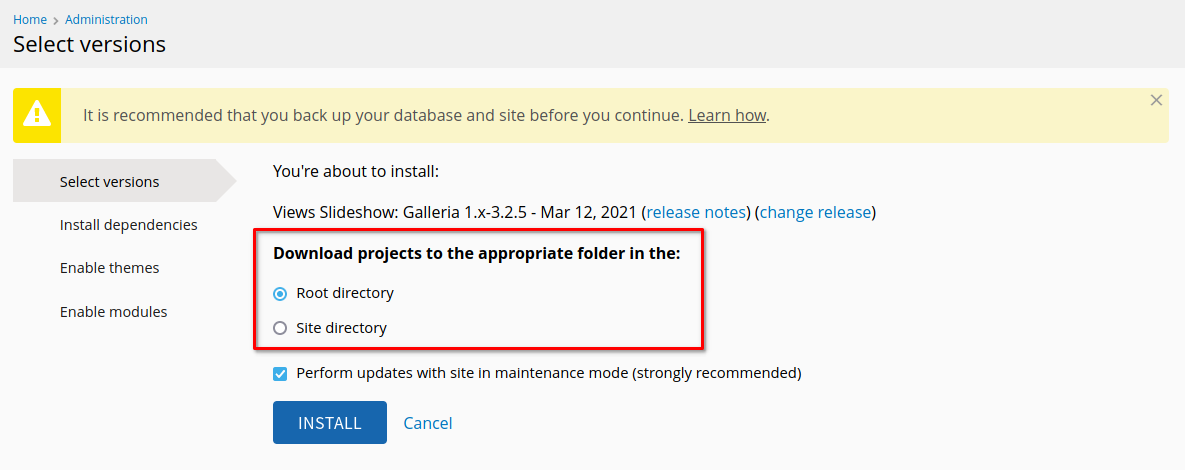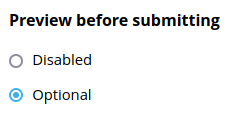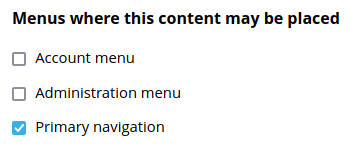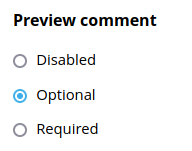New issue
Have a question about this project? Sign up for a free GitHub account to open an issue and contact its maintainers and the community.
By clicking “Sign up for GitHub”, you agree to our terms of service and privacy statement. We’ll occasionally send you account related emails.
Already on GitHub? Sign in to your account
[Multisite] Provide option for installing global or site-specific projects via the UI #3274
Comments
|
Yes, I just started playing with Project Installer for the first time and saw this. |
|
This is intentional apparently, same in Drupal: https://api.backdropcms.org/api/backdrop/core%21modules%21system%21system.updater.inc/function/ModuleUpdater%3A%3AgetInstallDirectory/1 @BWPanda think we should change this? Or close this issue? I guess it makes sense that contrib project should go into their main folder; only really custom projects need to go into the multisite folders. Unless anyone objects... |
|
I object. Putting projects in the root directories is for when they're used for all sites. But why assume that's the case here? Why assume that installing a module from the UI of a specific website means that module is going to be used on other websites? I think if we're not willing to change this outright, we should at least provide an option to specify where new modules are installed... |
|
Hmm, I am leaning towards what @BWPanda is suggesting at the moment. If I am installing a module/theme/layout from the admin UI of a specific site, then I expect that to be installed/available only for that site. Having said that, I see the reason why some might want it to be done the other way (installed globally, for all sites), but cannot think of any way to make this more intuitive ...unless we provide an option in the Installer UI. |
|
I'm going to change this from being a bug, and leave it open for now. Maybe call it a feature request. |
|
Yeah, I think that how this would work ideally is if there was something like an "Install for all sites" checkbox somewhere in the installer steps, and then have the installer extract files to the proper dir. Depends on the code/logic complexity if this should be in core, or contrib. ...sound like a fun/interesting problem/task 🙂 |
|
I don't see how this is a potential contrib fix... As for code complexity, should be fairly simple. Drush and |
|
@BWPanda as I said, this sounds like a very interesting problem to solve, and it would save work/time for people, so UX++ (site builders). I may take a crack at it ...if either you or anyone else don't beat me to it 🙂 |
|
Here's a PR: backdrop/backdrop#3946 It adds a new field to the 'Select versions' form (only for multisites, if it's not a multisite this field isn't shown): And a Lando file for testing can be found here: #4151 |
|
@BWPanda cool, I'll try to test soon. One thought about wording: that "Root directory" feels a bit misleading. For sure the modules wont land in the "root". The label contains the required context info, but the label and option aren't so easy to connect. Wording usually isn't my biggest talent, but how about a shorter label above and with the options?
Update: wait, isn't this also for themes and layouts? Then my suggestion makes no sense. |
|
Yup, we should simplify, so that it makes sense to less technical people. Perhaps something that says:
Perhaps also denote the actual file paths? (as help text to each individual option)
Right, we'd need to account for all that. |
|
...I just recalled some very good advise from @olafgrabienski on another thread re making sure that the labels of fields and the respective options are all individual sentences that can stand on their own. So my previous suggestion would need to be tweaked accordingly. I don't have a good suggestion at this time, but you get the point 😉 |
|
...this is as good as I could get it to:
|
|
I originally considered two ways to word this:
I went with the first one, but I'm happy to try the second.
I'm happy to try different wording, but I disagree with that premise. This field is only shown for multisites, and if someone is using a multisite then they would know the difference between the site-specific directory and the root directory. You could argue that someone might just be managing a site that was setup by someone else (e.g. a site admin with no access to the file system), but I still think they'd need to know the difference, especially when they can be installing modules that will be available to other sites (which they might not manage).
I also disagree with this. Examples from core that don't do this: If the plan is to ultimately change those too, I think that's just going to unnecessarily duplicate words in the UI. I mean, that's what field labels are for: giving context to the options so we don't have to repeat the same thing for each one. If we don't plan to change the above examples, then I don't see the point of changing this PR either. I've updated the PR to add a description to each option with the path in question. If we want to try the 2nd wording as described above, then I don't think a path in the description makes sense then... Now looks like this: |
|
TBH, I actually liked the direction of @klonos' suggestion, though not ideal (yet). But I usually can't help much with wording. And I still find the word "Root" misleading and rather confusing (even for the "slightly more technical user"). 😉 |
@BWPanda I agree the examples shouldn't be changed but they don't match what I had in mind. I don't think, labels and options have to be individual sentences. However, if there are sentences,
Incomplete sentences like Example for an alternative:
|
|
Thanks @olafgrabienski, that makes more sense. |
|
Yes, what @olafgrabienski said ^^ ...sorry I failed to explain things properly. That's what I meant. PS: The explanation and examples that @olafgrabienski provided should go somewhere in our documentation and/or coding standards. I'll make sure that that gets done. |
A lot better! One thought: Is the "/app/www" part of the example path actually helpful? How about "/modules/" and "/sites/example.com/modules/"? |
|
Yup, very much better @BWPanda 👍🏼 ...and I like @indigoxela's suggestion too 👍🏼 (changing the |
So that's dynamically generated based on the actual site. The root path is obtained using The reason for the |
In that case (and sorry I didn't check the actual code before commenting), I believe that it is indeed helpful having those there 👍🏼 ...but should we then remove the |
...or replace them with |
|
The reason I used |
|
Right 👍🏼 ...I missed that. |
|
So lots of feedback here, but anyone actually want to test/review? Or if you have already, tag it as such? |
|
@BWPanda - I've tested this. If the modules folder has not yet been created in the sites/multi_one/ folder then the UI cannot install the module. This is the error I get: PS - this is exactly what is rendered on screen - this is not an error with copying. It is exactly the same in the log. Once |






Describe your issue or idea
In multisite, if you install a module with the project installer, it goes into the root
/modulesfolder, instead of thesites/sitefolder/modulesfolder as expected.The text was updated successfully, but these errors were encountered: